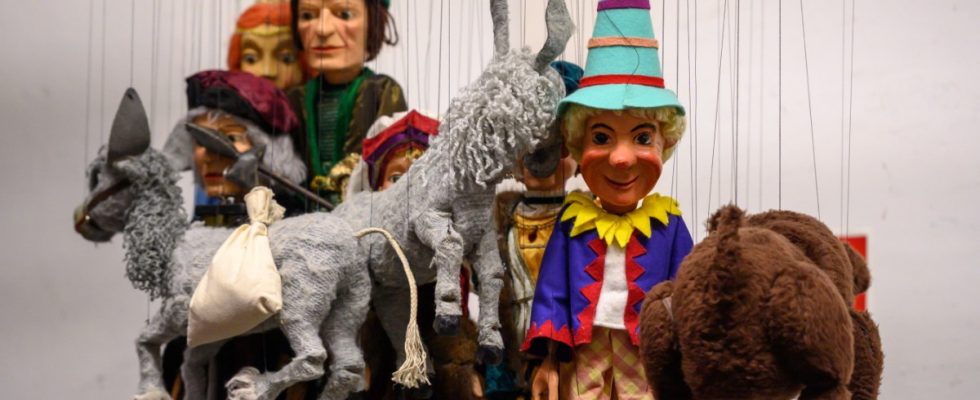It’s like in a fairy tale. A girl visits the Augsburger Puppenkiste, runs away from her father and up a spiral staircase. But strangely, the twelve-year-old shrinks with every step, and her iPhone also goes out. Until the girl discovers wooden frames with marionettes hanging from them in the dim light of an attic. Some of them seem to be alive, a stork clatters by, the pig Frau Wutz and the robber Hotzenplotz appear, Jim Button and the princess Li Si. And suddenly there’s a woman with a cigarette and says: “I’m Hatü.”
The woman, blown like a ghost from the old days, actually existed: Hatü was the nickname for Hannelore Marschall-Oehmichen, whose father founded the Augsburger Puppenkiste with a small (family) troupe in 1948. This year the famous stage celebrates its 75th anniversary. A good reason to revisit the beginnings and development of this marionette theater – and to read Thomas Hettche’s fine novel “Herzfilament”, which was published three years ago, again.
Don’t let yourself be deceived, especially not by the simple yet poetic language of the book: It’s only a harmless fairy tale at first glance. Because Hettche, like a puppeteer, easily intertwines different levels. Despite its easy readability, the novel achieves a degree of complexity that makes reading for young people and adults alike beneficial.
The fact that the levels change is easy to understand in the book: the modern fairy tale, in which a girl ends up in an attic and embarks on an adventure, is printed in red. The plot is narrowly drawn with sections in blue letters: here the readers follow the biography of the marionette player and carver Hatü from childhood to the first years of success at the Puppenkiste.
The famous Urmel from the ice can be seen together with pig Mama Wutz in the doll box museum.
(Photo: Stefan Puchner/dpa)
The beginnings of childhood are by no means happy. Because soon there will be war in the life of Hatü and her family. The father Walter Oehmichen, head director at the Augsburg City Theater, is drafted. And in 1940, as a soldier quartered in a school in Calais, he found a puppet theater there. He begins to make puppets out of cardboard and improvise scenes, with astounding effect: “It was very different from the real theatre,” says the father in the novel, and yet the rickety figures were “alive” – and the soldiers, ” all tough guys who had experienced horrible things suddenly became children again”.
The father can’t let go of this experience of a transformation. After his release, he builds a “puppet shrine” which, after the first small performances, burns down in a bomb attack on February 26, 1944. After further military service and being a prisoner of war, Oehmichen dared a second attempt in 1948: the Puppenkiste was out in the world – and the daughter Hatü had long been infected by the enthusiasm.
Both father and daughter love the grace that is inherent in puppets as airy beings. “The threads they are attached to are attached exactly in their center, which is why you think their movements have something like a soul,” enthuses the father. And he even tries to convince Hatü and her sister of the existence of a “heart thread”: This is the most important thread of a puppet, he claims, because “it is attached to the viewer’s heart”.
Thomas Hettche also shows the city of Augsburg in all its ambivalence.
(Photo: Arne Dedert/dpa)
But this artful novel is not just about explaining the magic of marionettes and floating effortlessly through time and space in a literary way: Hettche also carefully unravels the entanglements – not only – of his father in National Socialism. And in general creates a very clear, detailed picture of the city of Augsburg at that time.
For example, you can literally see in front of you how at the beginning of the war in 1939 a large number of swastika flags were hanging from the Augsburg Perlach Tower and the town hall, “close to each other the red fabric billowed sluggishly in the heat”. One can feel the later fear of the inhabitants of the city, in which there are companies important to the war effort from Messerschmitt to MAN, of the impending bombing raids. In an exemplary and oppressive manner, however, Hettche also illustrates the disenfranchisement and deportation of the Jewish inhabitants, whose fate hardly interests anyone.
This ambivalence is embodied by cheerful puppetry and enigmatic repression by the character of Kasperl. The deeper meaning that a Punch and Judy doll carved by Hatü has for this novel should not be revealed at this point. In any case, it connects the various spheres and concerns of the novel, in which it is not accidentally once said: “The past is the present and the present is the past.” And: “Time dissolves in darkness. In a story, it reassembles.” Like in this book.
Thomas Hettche: heart thread. Roman of the Augsburger Puppenkiste. Kiepenheuer & Witsch 2020, 288 pages, 24 euros, e-book 9.99 euros.

